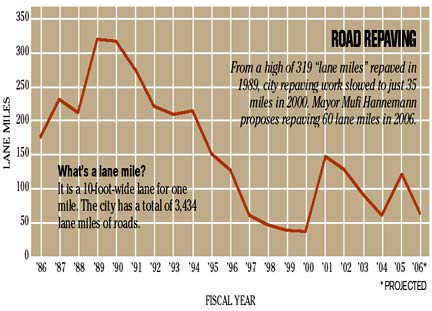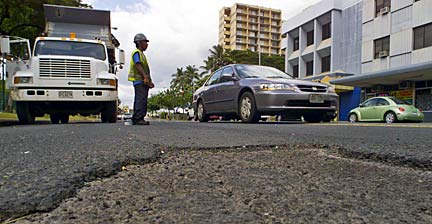
|
Hole lot of trouble
Cutbacks in road repaving show
with the increase of potholes
Mayor Mufi Hannemann declared "a war on potholes" in his first State of the City speech last month, proposing to nearly triple the amount of asphalt the city buys for potholes and other road mending, at a cost of $1.2 million.
He also intends to use city crews for "first-aid" repaving of about 20 miles of suburban streets, a practice phased out by former Mayor Jeremy Harris in 2001.
![]()

From a high of 319 lane miles repaved in 1989, the city slipped to a low of just 35 lane miles in 2000. A lane mile is the equivalent of a 10-foot-wide lane for a distance of a mile.
In 2004, the city used 2,058 tons of asphalt to fill 70,937 potholes -- up from 905 tons of asphalt used for 29,283 potholes in 2001.
The onslaught on the city's 3,434 lane miles of streets is constant. Wear and tear comes from traffic, especially heavy trucks, and from water, in the forms of rain, ocean waves and groundwater, said Road Maintenance Division Chief Larry Leopardi.
"I think it's worse than ever," said Dominick Pinheiro of Whitmore Village. "Potholes are practically everywhere -- on Nimitz, in Wahiawa, even on the freeway. It's terrible."
Pinheiro drives an older-model Toyota Tercel, which so far has escaped any pothole damage. "But you can really do some damage," he said. "It's worse when it rains and you see a puddle and you don't know what's under there."
Claims against the city for vehicle damage from hitting a pothole have increased as well: 353 claims were filed in 2004, up from 64 in 2003 and 39 the year before.
In 2002, the city paid $10,485 to settle the 21 claims it agreed to pay, said Marie Manuel Gavigan, a deputy city corporation counsel. No one has totaled the payments made in 2003 or 2004, she said.

During their shift on Thursday, Acoba shoveled 2 tons of steaming hot asphalt from the back of a truck into pukas in dozens of city streets.
Smith drove the truck, then got out to deftly use what looks like a giant shower squeegee to spread shovels full of asphalt level over potholes and other gaps in the pavement. Then Acoba took a metal post with a flat bottom and tamped the asphalt down.
It's a process that city pothole crews repeat about 70 times a day, said supervisor Mel Miyata.
Usually there's just one crew out at a time, but often there are two, Miyata said. Sometimes, as after a heavy storm, four teams are dispatched.
"I come to work in the morning and see a stack like this," Smith said, fanning out the pothole reports he and Acoba dealt with Thursday.
Despite the fact the pothole guys make driving smoother for everyone, they don't often get direct thanks.
"They make complaints to fix the potholes, then they complain when we come fix 'em," Acoba said as he watched drivers wait impatiently to get around pothole work that blocked a lane of Beretania near Aala Park.
Just then, a woman walking by stopped to say, "Do a good job now, guys."
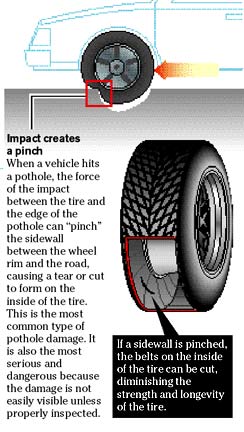
Until the city resumes a planned program of resurfacing major streets every 10 years and suburban streets about every 15 years, the potholes will keep coming, Leopardi said.
Hannemann's proposed 2006 budget doesn't earmark any more money for Road Maintenance Division wages than this year's budget. And it reduces spending on contracted road repaving by $10 million.
Still, Leopardi said he hopes to be able to shift existing workers to road work who in recent years have been required to do work related to Brunch on the Beach and other programs.
City crews deal with road maintenance in three basic ways, Leopardi said: by patching potholes, which usually measure inches across; by "block-patching" areas up to a 5- or 10-foot diameter; and with a paving machine that can resurface whole streets, providing the underlying pavement doesn't need major reworking. Companies are contracted to repave streets that need to be ripped up and rebuilt.
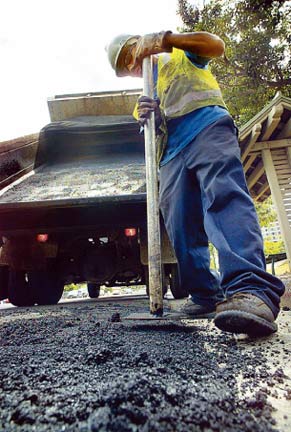
City road repair crewman Nobo Acoba filled a pothole Thursday on Beretania Street. The city filled 70,937 potholes last year.
Hannemann was off island and unavailable for comment on why he is reducing the amount of contracted repaving.
Lee confirmed that among streets scheduled for contracted repaving are: Waimano Home Road in Pearl City, Makakilo Drive, Pupukea Road and nearby Kahuku residential streets, and Paiwa and Lumiaina streets in Waipahu.
Miyata, a 30-year veteran of city road work, said he'd rate the current state of the city's streets a 3 on a scale of 1 to 5, with 5 being best. The effects of several years of less repaving is showing, he said.
Despite grousing about potholes on the roads, not everyone thinks Oahu is in bad shape.
Pamela Fox, who now lives in Kapolei, said the potholes on Oahu are nothing compared to the craters she encountered in her former home of Albany, N.Y. "There, the snow and the salt on the roads is a problem," she said. "Here is nothing in comparison."
Still, in decades of working on pothole crews, Smith described how many times there's been a day with no potholes reported: "Never."
If you hit a pothole» If you think damage has occurred, visually inspect the tire for tears, cuts or bulges on the sidewall.» If you are not sure the tire is damaged, have it inspected immediately by a reputable technician. » If you hear any thumping noise after impact, your rim may be bent or warped. Have it inspected immediately by a reputable technician. » When buying a tire, consider a road hazard warranty that allows you to replace a tire based on remaining tire life.
Source: Lex Brodie Tire Co.; http://lexbrodies.com/video_9.html (video 9, Tire Blowouts)
Pothole hotlinesCity streets: 527-6006State highways: 536-7852
Pothole damage claimsIf you think hitting a pothole on a city street damaged your vehicle, you can file a claim with the city corporation counsel. Call 523-4639 for a form. A description of the pothole location and repair bills or damage estimates for the vehicle are required.
|
Potholes ... and more
Potholes are a symptom of a road wearing out. There are three main causes -- water, heavy vehicles and volume of traffic. Repair crews have names for different types of holes in the road.
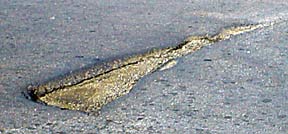
![]()
Pothole
A bowl-shaped depression in pavement, caused by collapse of the foundation layer under the asphalt. Can be just an inch-deep bump or a jarring several-inch drop-off. This example is at Kapahulu Avenue at Kalakaua Avenue.
![]()
Alligator cracks
Interconnecting cracks that look like alligator scales are potholes in the making. This example is at Kapahulu Avenue at Kalakaua Avenue.
![]()
Peel-offs
This happens when a layer of asphalt peels off the underlying layer. Usually shallow, but can precede worse problems. This example is on Kapiolani Boulevard in front of McKinley High School.
![]()
Shoving
A corrugated effect caused by heavy vehicles making frequent stops. Common in curbside lanes at bus stops. This example is on Kapiolani Boulevard.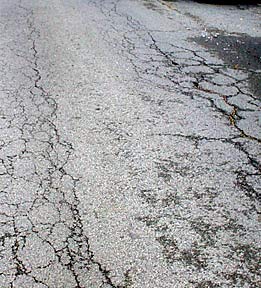
![]()
Ruts
Vertical depressions in the pavement surface where vehicle wheels travel. Indicates high wear since the last maintenance repaving. This example is at Birch Street, between Elm and Rycroft streets.
Spending on road repairMayor Mufi Hannemann proposes spending $1.2 million more to fix potholes next fiscal year. Here's what is being budgeted for the Division of Road Maintenance and for contracted repaving jobs:
Source: City and County of Honolulu History of potholesThe amount of asphalt used to fill potholes by the Division of Road Maintenance since fiscal year 2001:
Source: City and County of Honolulu City & County of Honolulu
www.co.honolulu.hi.us |
[News] [Business] [Features] [Sports] [Editorial] [Do It Electric!]
[Classified Ads] [Search] [Subscribe] [Info] [Letter to Editor]
[Feedback]

